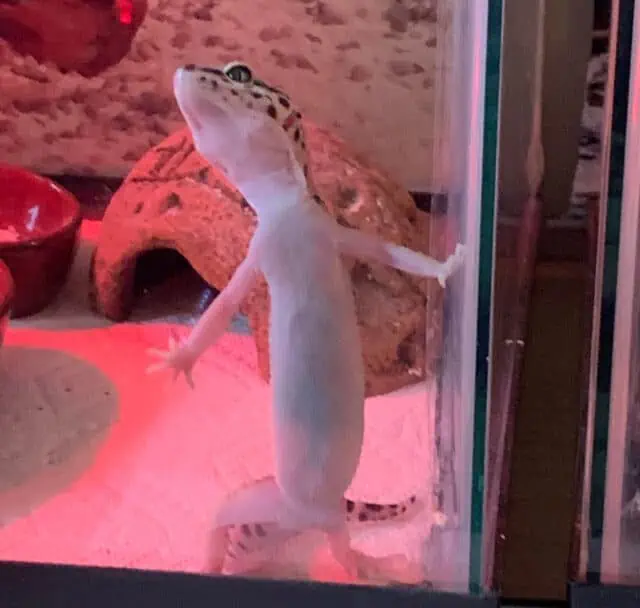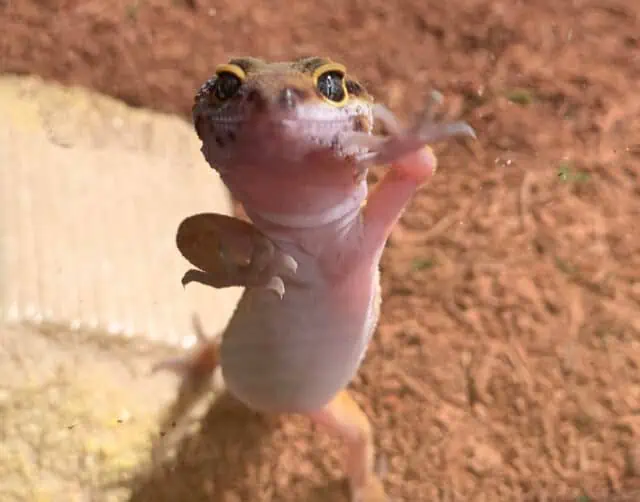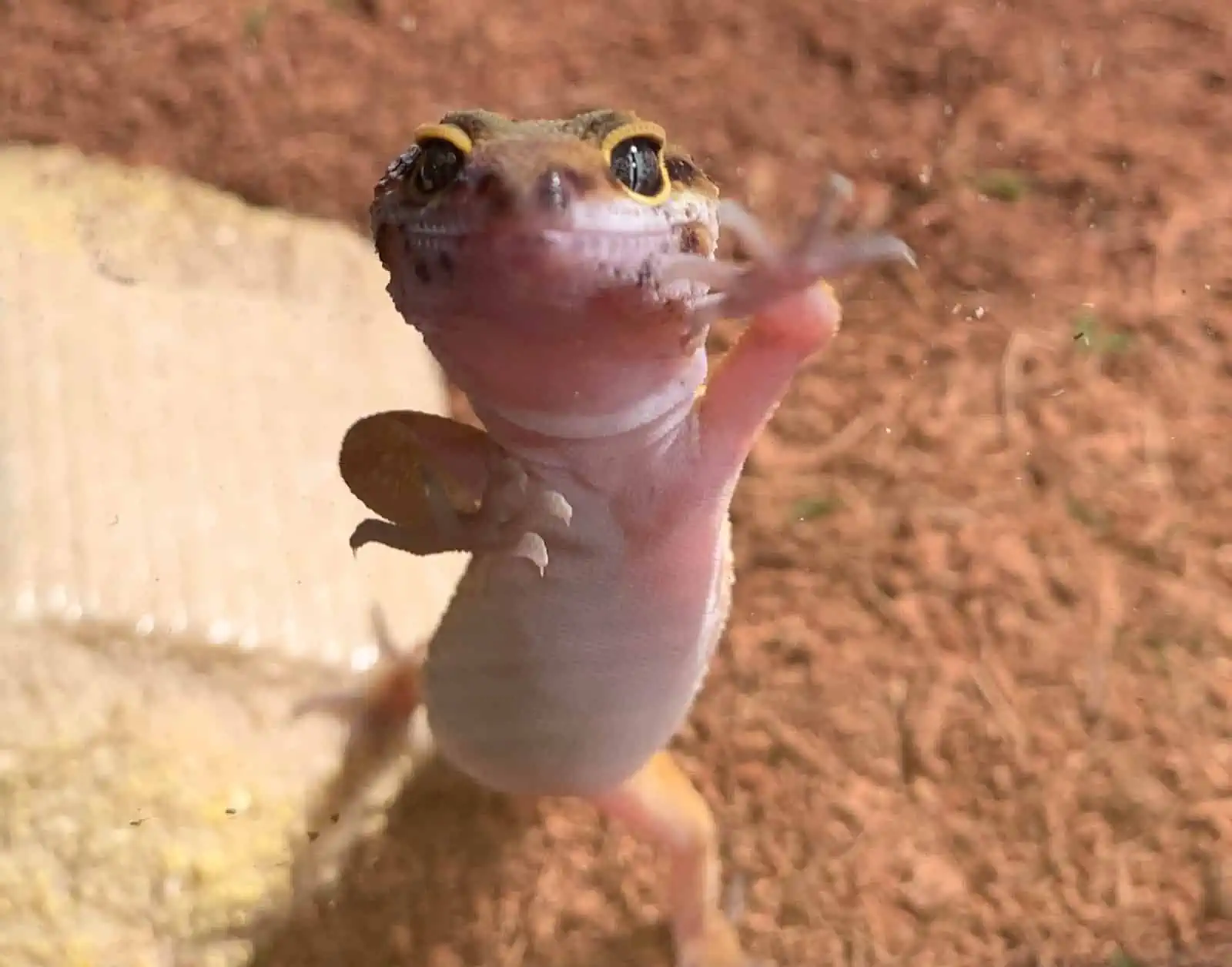Leopard geckos, with their distinctive, spotted appearance and docile nature, are a popular choice for reptile enthusiasts. But observing your leopard gecko engaging in glass surfing—pawing or climbing the glass walls of their enclosure—can leave you puzzled and concerned.
Glass surfing is commonly a sign that your gecko is experiencing stress, discomfort, or curiosity. This behavior can be triggered by various factors such as hunger, environmental stress, inadequate tank conditions, or a desire to explore.
Definition: Glass surfing refers to the behavior exhibited by a gecko when it elevates itself on its hind legs, while its abdomen makes contact with the glass, and it mimics a ‘paddling’ movement with its forelimbs.
Addressing Glass Surfing: Understand and identify various causes of glass surfing in leopard geckos, such as hunger, stress, and inadequate tank conditions.
Tank Setup Matters: Ensure the enclosure has appropriate lighting, sufficient space, and proper humidity levels to keep your gecko comfortable and stress-free.
Behavior Insight: Recognize different behavioral aspects that may lead to glass surfing, like seeing their reflection, searching for a mate during breeding season, or exploring new environments.
Health Implications: Be mindful of the signs indicating stress or health issues, like excessive eye licking or surfacing due to mites, and address them promptly.
Minimizing Distractions: Regulate external factors like bright lights and movement outside the enclosure to create a peaceful environment for your leopard gecko.
Why Is My Leopard Gecko Glass Surfing?

Leopard geckos may exhibit the peculiar behavior of glass surfing for several reasons. It’s crucial to observe closely and understand the underlying causes to ensure the well-being of your pet.
Glass surfing typically occurs when leopard geckos feel the need to explore. This may be a new environment they find themselves in or could be due to changes within their existing habitat. Exploring their surroundings is a natural instinct, driven by both curiosity and a need to familiarize themselves with the terrain, searching for food or escape routes.
Hunger is another common reason behind glass surfing. When leopard geckos are hungry, they may become more active and attempt to climb the glass walls of their enclosure, possibly to catch your attention and demand food. Regular and appropriate feeding can mitigate this behavior, maintaining a content and healthy gecko.
Low humidity levels within the enclosure can also trigger glass surfing. Leopard geckos require a certain level of humidity to shed their skin properly, and inadequate humidity can lead to discomfort and stress, prompting them to seek more suitable conditions.
Stress, resulting from various factors like improper lighting, overcrowding, or presence of predators, can lead to glass surfing as well. Identifying and mitigating the stressors is crucial in maintaining a happy and healthy environment for your gecko.
Lastly, an inadequate tank size can make your leopard gecko feel confined and stressed, leading to glass surfing. A spacious and well-organized tank can allow them to exhibit their natural behaviors comfortably.
14 Reasons Why Leopard Geckos Are Glass Surfing

Leopard geckos, with their vivid colors and docile nature, make fascinating pets, yet their behavior can sometimes be puzzling. Glass surfing is one such behavior that can perplex even seasoned gecko enthusiasts.
While it’s critical to understand the typical reasons, such as exploration and stress, it is equally vital to delve deeper and explore a myriad of other factors that can induce glass surfing in leopard geckos.
Bright Lights and Overhead Lights
Bright and overhead lights can present several issues in a leopard gecko’s enclosure, potentially being a significant stressor. These lights, especially if too bright or left on for extended periods, can cause considerable discomfort to leopard geckos. This discomfort often leads to the geckos engaging in glass surfing behavior as they try to escape the intense light exposure.
Bright lights can disrupt their normal activity cycles and disturb their natural behaviors, contributing to stress levels and subsequent glass surfing. It’s crucial to understand that in the wild, leopard geckos are nocturnal, and exposure to excessive light can be unnatural and stressful for them.
To mitigate this stress and prevent glass surfing induced by bright lights, providing appropriate lighting setups is critical.
Maintaining a regular and natural light cycle and ensuring that the enclosure is not exposed to excessive light, especially during the gecko’s resting period, is paramount.
This involves having controlled lighting setups that mimic their natural environment, balanced temperatures, and enabling a more harmonious living condition for the geckos.
When It’s a New Environment – Exploring
Leopard geckos often display glass surfing behavior when introduced to a new environment as they explore their surroundings.
Being in an unfamiliar setting can lead to a combination of stress and curiosity, prompting the gecko to investigate every nook and cranny of their new home. This exploratory behavior is a natural response, helping them understand their environment and find hiding places, food, and potential escape routes.
New environments trigger glass surfing in leopard geckos mainly due to their inexperience and curiosity. They are keen to explore and understand their surroundings, especially when they find themselves in a novel space.
Additionally, the transparent glass walls of their tank can also provoke glass surfing. These walls allow them to see outside their enclosures, possibly leading them to attempt to move through these transparent barriers, driven by curiosity or perceived opportunities to explore further.
Recognizing this behavior as a natural response to new environments, owners should be patient and give their leopard geckos ample time to acclimate.
Providing various hiding spots, maintaining optimal environmental conditions, and minimizing stressors can aid in reducing the frequency of glass surfing as the gecko becomes more accustomed to its new surroundings.
Hungry – Searching for Food
Leopard geckos may engage in glass surfing when they are hungry, moving along the glass as a way to search for food. This action is sometimes more than a quest for sustenance; it may also be a way for them to get their owner’s attention and communicate their need to be fed.
These intelligent reptiles are capable of picking up on feeding routines, and they quickly learn when it’s time to eat.
When a leopard gecko is hungry, they may become more active and display behaviors such as glass surfing to express their desire for food.
They may roam around their enclosure, approach the glass repeatedly, and appear more alert and responsive to their owners. This behavior is their way of signaling that they are ready to eat and is typically not a cause for concern.
Low Humidity Levels
Low humidity levels in the enclosure can lead to a host of problems for leopard geckos, including difficulties with shedding and heightened stress levels.
Leopard geckos, originating from arid environments, require specific humidity levels to stay healthy. When these levels are not met, it can lead to discomfort and instigate glass surfing behavior as they possibly seek more suitable conditions.
Leopard geckos usually experience shedding problems when the humidity levels are inadequate. This can cause stress and discomfort, prompting the gecko to roam around the enclosure and glass surf, possibly in an attempt to find an area with more suitable humidity levels within their environment. When they are unable to find relief, glass surfing becomes a manifestation of their distress.
The ideal humidity level for leopard geckos is around 20% to 40%. Maintaining proper humidity is essential for their well-being. This can be achieved by using a suitable substrate, providing a moist hide, and monitoring the enclosure’s humidity levels regularly.
Adequate humidity ensures that leopard geckos can shed properly and are comfortable in their surroundings, helping to prevent stress and the associated glass surfing behavior.
As a Sign of Stress
In leopard geckos, stress can manifest in several ways and addressing them promptly is crucial for the well-being of the gecko. Recognizable signs of stress include tail waving, stress licking, and eye licking, each of which serves as a clear indicator that the gecko is experiencing discomfort or anxiety.
Tail waving is usually a defensive behavior, showing that the gecko feels threatened. Stress licking and eye licking are other common manifestations of stress. Such behaviors, when spotted, should prompt immediate attention and assessment of the gecko’s environment and health, as prolonged stress can lead to more severe conditions like mouth rot, a serious and painful infection.
Addressing stress involves ensuring the gecko’s habitat is properly set up and maintained. This includes providing a suitable tank that is spacious and secure, maintaining appropriate humidity levels to avoid shedding problems, and offering a balanced diet.
Cohabitation, or housing multiple geckos together, can also lead to stress, and is generally best avoided, especially with males, to prevent territorial disputes and fighting.
Tank Size Too Small – Overcrowding
Leopard geckos require ample space to thrive, and a cramped tank can lead to stress and discomfort. The starting point for housing a leopard gecko is a tank of at least 20 gallons, designed to accommodate their need for space to roam, explore, and hunt.
Housing leopard geckos with others, especially of the same sex, is generally discouraged to prevent territorial disputes, stress, and overcrowding, each of which can lead to negative behaviors like glass surfing.
Providing enough floor space is essential as leopard geckos are ground-dwelling creatures, and they prefer wide spaces to climb. It’s equally important to minimize clutter within the tank; a cluttered environment can overwhelm and stress them, contributing to overcrowding feelings even in a suitably large tank.
He Sees His Glass Reflection And Thinks It’s Another Gecko
Leopard geckos, when encountering their reflection in the glass of their enclosure, may mistakenly interpret it as another gecko, leading to intriguing behaviors. They may exhibit signs of territorial aggression, as in the wild, encounters with other geckos usually pertain to competition for resources or mates.
Consequently, this mistaken identity can cause the gecko to climb the glass walls in an attempt to confront the perceived intruder.
Owners should observe for signs of stress and aggression, especially in tanks housing multiple geckos, such as tail waving, rapid movement, and vocalizations. Identifying these signs early can prevent escalated conflicts and potential harm to the animals.
Addressing this behavior may involve minimizing reflections in the tank and monitoring interactions between tank mates closely. If a gecko displays persistent aggression, even when alone in the tank due to reflections, it might be beneficial to adjust the tank setup or lighting to minimize reflections.
Extreme Temperatures
Extreme temperatures can have a substantial and detrimental impact on leopard geckos. When exposed to temperatures that are too high or too low, they can exhibit symptoms such as panting, immunosuppression, food rejection, and lethargy. These symptoms are indicative of discomfort and potential health issues, arising due to the gecko’s inability to properly regulate its body temperature in extreme conditions.
Leopard geckos are ectothermic animals, meaning they rely on their environment to regulate their body temperature. They need specific temperature ranges in their enclosure to thermoregulate effectively. When the temperatures in their enclosure are not within the ideal range, geckos will often seek out areas that are more comfortable, and may even resort to glass surfing as they try to find a more suitable environment.
For a healthy and comfortable habitat, different areas within the enclosure should maintain distinct temperature ranges. The basking area should ideally be around 88 to 92 degrees Fahrenheit, the warm side around 80 to 85 degrees, and the cool side should be kept at approximately 75 degrees.
Spraying with water may be required in order to bring their environment to the right humidity level.
Doesn’t Have Enough Hiding Places
Hiding places within a leopard gecko’s tank play an essential role in ensuring the well-being and comfort of these creatures. Without adequate hideouts, leopard geckos can experience elevated stress levels and may exhibit glass surfing behaviors as a form of expressing discomfort and seeking refuge.
Providing suitable and sufficient hiding spots is an important aspect of replicating their natural habitat, and it allows them a sense of security and comfort within their enclosures.
In their natural environments, leopard geckos are accustomed to having a plethora of hiding spots available to shield them from predators and excessive light, allowing them to rest and avoid stress.
Therefore, it’s crucial to replicate these conditions within their tanks by introducing a variety of hiding options, reflecting their natural surroundings and providing them with the sense of safety they seek.
To make their enclosures more conducive and comforting, consider integrating various hiding options such as burrows, tunnels, and spaces under rocks or vegetation.
Wrong Substrate Choice
When setting up the enclosure for leopard geckos, the choice of substrate can substantially impact their health and well-being, and the wrong substrate choice can lead to various issues, including skin, eye, and respiratory irritations.
Some substrates, like wood shavings and gravel, contain harmful oils and dust that can irritate the gecko’s skin and eyes and may induce respiratory problems, further leading them to exhibit stress behaviors such as glass surfing.
Substrates containing smaller, sharp, or coarse particles should be avoided as they can cause harm to the gecko. These can lodge in their eyes, abrade their skin, or be inadvertently ingested, causing internal blockages and complications.
To avoid these issues and to create a more comfortable and safer environment for leopard geckos, opting for flat, smooth coverings like paper towels and newspapers is recommended.
For Breeding Purposes
Leopard geckos can exhibit glass surfing for various reasons, one of them being during their breeding season. This specific behavior is particularly pronounced in female leopard geckos who are kept alone and are in search of a mate. During the breeding season, usually in spring, these females may be observed frequently glass surfing, reflecting their innate drive to find a partner and reproduce.
Male leopard geckos may also occasionally display glass surfing behavior during the breeding season, possibly driven by a similar motivation to find a mate. However, this occurrence is generally less frequent in males compared to females.
Because of Mites
When a leopard gecko is infested with mites, it may engage in glass surfing behavior as a way to express discomfort and irritation caused by the parasites. Mites can be very stressful for leopard geckos, causing them to bite, claw, and exhibit irritation. Detecting mites early is crucial and involves inspecting the gecko’s skin folds and around the eyes, areas where mites tend to congregate.
In order to treat mite infestations effectively, the leopard gecko should be removed from its tank immediately. Following this, a thorough cleaning of the enclosure and all the accessories is mandatory to eliminate any remaining mites or eggs. The use of acaricides can also aid in controlling and eliminating mite populations, eradicating the infestation more effectively.
Distractions Outside the Enclosure
Leopard geckos are sensitive creatures, and various distractions outside their enclosure can significantly impact their behavior, leading to glass surfing. Distractions such as bright lights, the flickering of TV screens, or the presence of other pets can be perceived as threats or points of interest, prompting the gecko to investigate or attempt to escape.
These external stimuli might cause stress and discomfort to the leopard gecko as they feel vulnerable to the perceived threats or are intrigued by the movements and lights. In such situations, they might exhibit glass surfing behavior, trying to move towards or away from the distractions, depending on their perception of it as a threat or an attraction.
Shedding
Shedding is a natural, essential process for leopard geckos, allowing them to grow and maintain healthy skin. During their lifetime, leopard geckos will undergo numerous shedding cycles, where they will lose their old skin to make way for new, healthy skin. This process, while normal and crucial, can cause significant discomfort and irritability in leopard geckos.
The discomfort associated with shedding often alters the behavior of leopard geckos. It can make them more active and anxious, leading them to exhibit glass surfing behavior as they experience irritability from the tight, old skin. This increased activity and glass surfing might be their way to cope with the unease accompanying the shedding process.





